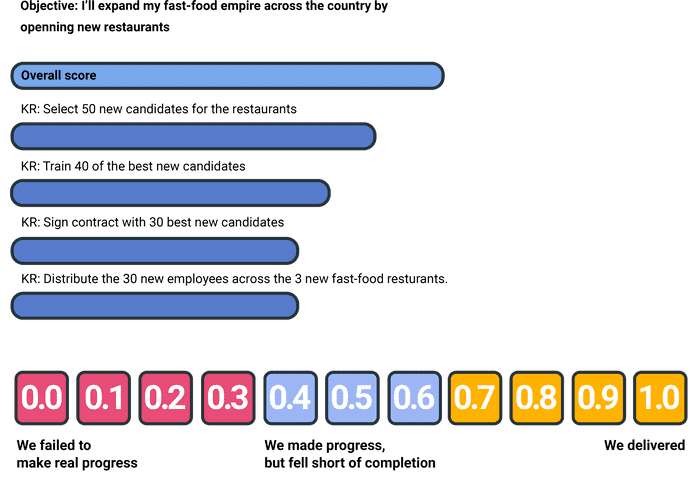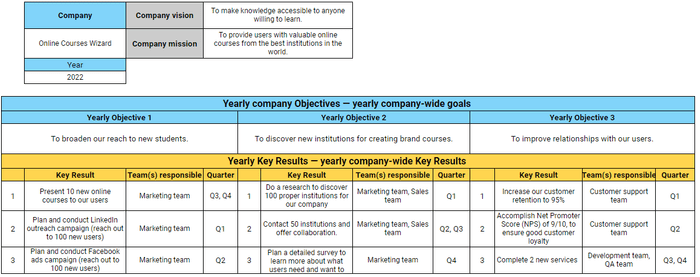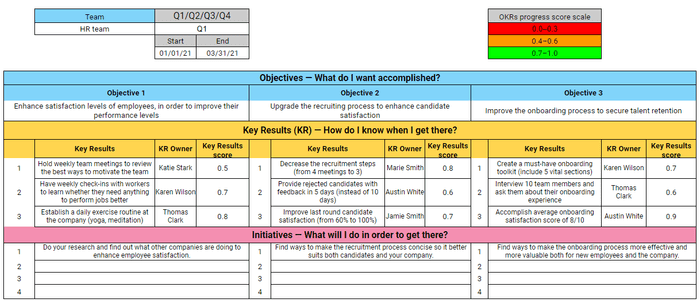Objectives and Key Results (OKR): everything you need to know
Last updated on: November 26, 2021
It’s been 85 years since British philosopher, Alec Mace, developed the goal-setting theory and declared that setting goals is an efficient way to help people achieve more in their lives. And, truthfully, research does show that people with clear goals are 10 times more successful in their lives than people without goals.
So, what’s the role of Objectives and Key Results in all of this?
Well, Objectives and Key Results (OKR) is a goal-setting framework that emerged as a solution to help several of the biggest companies in the world, including Google, set their goals.
In this detailed guide about Objectives and Key Results, you’ll learn:
- What are Objectives and Key Results (OKR), in more detail?
- Where did they originate from?
- How should you grade them?
- What types of Objectives can you set?
- How do OKRs differ from other popular, goal-related frameworks such as Key Performance Indicators, SMART goals, and Scrum?
- How can you set up your own OKRs?
- How to use OKR templates?
- How do people across industries set their OKRs?
- And much more.
So let’s start.

Table of Contents
The introduction to the concept of OKR
In this section, you’ll learn about the basics of the OKR methodology, including the definitions of Objectives and Key Results, as well as the definition of Initiatives — another important element of the OKR framework.
What is the OKR methodology? What is the purpose of the OKR?
As already established, the OKR acronym stands for Objectives and Key Results — it is a goal-setting methodology whose main drive are its goal-related outcomes. Moreover, it is a popular performance, goal management, and strategic framework meant to help a company, team, or individual implement a goal-based strategy. Individuals may find special value in using the OKR framework to reach their career goals.
Each separate set of Objectives and Key Results needs to be:
☑️ Significant
☑️ Concrete
☑️ Action-oriented
☑️ Inspirational
The key elements of the OKR methodology are:
- an Objective,
- a Key Result,
- an initiative, and
- OKR weekly check-ins.
We’ll now take a closer look at each element.
OKR — What is an Objective?
How many Objectives does an OKR have?
According to the OKR definition, an OKR consists of 1–5 Objectives — by their nature, they are a qualitative concept, i.e. they are characterized by their quality and cannot be measured. They provide the direction, and answer the question of “What?”:
“What do I want to be accomplished?”
“Where do I want to go?”
The purpose of Objectives is to provide the definition for the goal(s) you want to pursue.
The characteristics of Objectives say that they should be:
- directed,
- aligned,
- high in impact power,
- easy to understand, and
- a means of inspiration.
Example:
You’re the CEO of a fast-food franchise, and you want to see your fast-food empire grow further. In this example, opening up more restaurants across the country would be a related Objective you will pursue, and you can phrase it like this:
Objective: I’ll expand my fast-food empire across the country by opening new restaurants.
OKR — What is a Key Result? How many Key Results does an OKR have?
Each of the 1–5 Objectives you set should have from 3 to 5 Key Results — by their nature, they are a quantitative concept and require specific numbers or figures, i.e. they need to be imeasurable. Or, as Marissa Mayer, the CEO of Yahoo, once put it: “It’s not a Key Result unless it has a number.”
The purpose of Key Results is to help you define the points of reference you’ll use to decide whether you’re successful in progressing toward the said Objective. In that sense, they can serve as your milestones. They answer the question “How?”:
“How do I know when I get there?”
“How am I going to accomplish that?”
The characteristics of Key Results say that they should be:
- easily measurable,
- specific, and
- bound to a specific time frame.
Example:
Let’s expand on the Objective to grow your fast-food empire by opening up new restaurants across the country and define the Key Results for it:
Key result 1: Select 50 new candidates for the restaurants
Key result 2: Train 40 of the best new candidates
Key result 3: Sign contracts with 30 best new candidates
Key result 4: Distribute the 30 new employees across the 3 new fast-food restaurants in the franchise
OKR — What are Initiatives? How many Initiatives does an OKR have?
Now, each of the 3 to 5 Key Results may also have distinct Initiatives meant to define the work needed to maintain progress on the said Key Results. They are specific actions and activities you’ll engage in and initiate in order to live up to your Key Results. There is a minimum of 1 Initiative related to a specific OKR.
They answer the specific question “What will I do in order to get there?”
The characteristics of Initiatives say that they should be:
- easily measurable,
- specific,
- controllable, and
- bound to a specific time frame.
Examples:
If we expand even further on the OKR about the fast-food franchise, here are the initiatives we might single out:
Initiative 1: Read all the resumes sent to identify the best 50 candidates
Initiative 2: Plan the training program for the 40 best new candidates
Initiative 3: Draw the contract for the 30 best new candidates
Initiative 4: Based on the previously collected data, draw conclusions on where you want to allocate the 30 new employees
OKR — What are OKR weekly check-ins and why are they important?
Apart from setting Objectives, Key Results, and initiatives, you should also think about having OKR weekly check-ins.
A weekly OKR check-in is a brief, up-to-20-minute-long, meeting for team leaders and all team members. The goal of these check-ins is to review the progress of your OKR by thinking about what you’ve accomplished so far as a team.
To prepare for such meetings, team leaders have to review team Objectives, Key Results, and initiatives.
In addition, managers can think about the following questions:
- Are you content with the OKR results of your team?
- Are there any issues and how to solve them?
- Do you have any ideas on how to improve the overall OKR process? If so, you should share them with the team.
Weekly OKR check-ins are vital because they help everyone involved in the OKR process learn from their past results (last week), as well as set priorities for the next week.
The History of OKRs
In this section, you’ll learn who invented OKRs, how the concept expanded, and what companies use this goal-setting framework to expand their empires today.
Who invented OKRs?
Objectives and Key Results have a rich and important history in the business world.
Historically speaking, Objectives and Key Results start with the emergence of Management by Objectives (MBO) — a strategic management model whose purpose is to enhance the performance of a company through the action of defining objectives both the company management and the company employees agree on.
MBO was first established in 1954 in the book The Practice of Management by Peter Drucker, a management consultant, and educator who laid down the foundation for today’s business corporations.
In 1968, Andy Grove, the co-founder of Intel Corporations took over to develop MBO further — he molded it into OKR as we know and implement it today.
How OKR evolved — and which companies use OKR today?
Now, the story of the most famous company that relies on the OKR framework in business also starts in the Intel Corporation.
In 1974 John Doerr, today’s famous investor in many top companies, joined Intel’s sales team and learned how to implement the OKR goal-setting framework.
In 1980, he moved on to Kleiner Perkins, a company that’d go on to invest in Google — Doerr served as one of Google advisers at the time and he introduced the OKR concept to Google’s founders.
OKR is still in use at Google today.
Other top companies that rely on the OKR framework include Facebook, Microsoft, Twitter, Amazon, Spotify, Adobe, LinkedIn, and many more.
OKR grading — How to do it?
An important element of working according to the OKR framework is remembering to grade your Key Results as you draw closer to your Objective. This section will focus on three main ways of OKR> grading.
Now, according to the previously mentioned Andy Grove, the inventor of the concept of OKRs, the main method for grading OKRs is a simple “Yes/No” approach.
So let’s start with that one.
OKR grading — the simple “Yes/No” approach
Take, for example, the Objective to grow your fast-food empire by opening up new restaurants across the country. Here’s how you may grade its Key Results:
Objective: I’ll expand my fast-food empire across the country by opening new restaurants.
Key result 1: Select 50 new candidates for the restaurants
Did you select 50 new candidates for the restaurants? YES
Key result 2: Train 40 of the best new candidates
Did you train 40 of the best new candidates? NO
Key result 3: Sign contracts with 30 best new candidates
Did you sign contracts with the 30 best new candidates? NO
Key result 4: Distribute the 30 new employees across the 3 new fast-food restaurants in the franchise
Did you distribute the 30 new employees across the 3 new fast-food restaurants in the franchise? NO
OKR grading — the decimal approach
Now, the “Yes/No” approach marked your efforts toward Key Results as either a success or a failure. But, there may be more details to your results than that, so, for a more advanced alternative method (also suggested by John Doerr), you can use the following decimal OKR scoring system that involves a scale ranging from “0.0” to “1.0”:

According to this system, OKR grading goes as follows:
- 0.0 – 0.3 — “We failed to make real progress”
- 0.4 – 0.6 — “We made progress, but fell short of completion”
- 0.7 – 1.0 — “We delivered”
If we use the aforementioned OKR example about fast-food restaurants, here’s how this decimal grading may look like:

Objective: I’ll expand my fast-food empire across the country by opening new restaurants.
Key result 1: Select 50 new candidates for the restaurants.
I have selected 50 new candidates for the restaurants —
that’s a perfect score of 1.0
Key result 2: Train 40 of the best new candidates.
I have trained 36 of the best new candidates —
that’s an almost perfect score of 0.9
Key result 3: Sign contracts with 30 best new candidates.
I’ve had 25 best new candidates sign contracts —
that’s a middling score of 0.8
Key result 4 Distribute the 30 new employees across the 3 new fast-food restaurants in the franchise.
I’ve distributed the 25 new employees across the 3 new fast-food restaurants in the franchise — once again, that’s a middling score of 0.8
OKR grading — the Confidence levels
Another method of OKR scoring is the Confidence levels method. This approach works for companies that need a more in-depth grading system.
The Confidence levels grading method consists of three different elements:
- red system: the one that indicates “we failed,”
- yellow system: the one that indicates “we made progress,” and
- green system: the one that indicates “we met our goal.”
Aside from these three colors, you can also use emoticons to express the team’s level of success. In that case, you can use happy, concerned, or sad emoticons.

So, how will the team leader know how to set these Confidence levels? Managers should think about the following question and try to answer it sincerely:
- How confident are you that the team will accomplish each key result?
However, it’s crucial to point out that it’s not only team leaders who participate in scoring Confidence levels. It’s important that all team members who are involved in the OKR process also take part in this OKR grading system. So, managers should hold meetings and have an entire team share their opinion on this matter.
In addition, if you and your team conclude that the Confidence level of your OKR process is not satisfactory (i.e., that it deserves a red system, it’s crucial that you don’t give up. Instead, have a team meeting and discuss a potential solution — a new strategy you can adopt.
How should you grade OKRs?
Now, the “Yes/No” approach shows that the answer to whether this Objective was accomplished is a “No”, with three “No’s” and only one “Yes”.
But, we needed more data to decide how successful/unsuccessful we actually were with the goal. So we used the decimal grading system as well.
So, the simple answer to whether we selected 40 restaurant candidates is a “NO” — but, we still selected 36 great candidates which is still an adequate number of candidates, as evident in the total grade for our Objective (0.9).
And, as we can see, the average grade of these Key Results is 0.9 for the entire Objective — which is a great grade, despite our three “No’s”.
However, the overall grade of the Objective or the separate grades of the Key Results still may not give you the entire picture.
Some KRs may be more important than others.
For example, you’ve scored 1.0 on the first Key Result that involved selecting 50 resumes.
However, the later Key Results were slightly more important for the Objective of successfully opening and staffing new fast-food restaurants — and their grades were lower.
So, make sure you emphasize your more important KRs and invest more effort in them — in total, it may be disappointing to score less than 1.0 on some KRs, and phenomenal to score 0.7 on other KRs.
Bonus tip: Grades among KRs may vary significantly — if you score 20% (0.2) on two KRs and 80% (0.8) on the other two KRs, you may need to rethink and rephrase your 4 Key Results, as they may not be evenly matched. In such cases, it may be best to rephrase and separate these Key Results into separate sets, for two different Objectives.
Types of OKRs?
So, we’ve seen how we can best grade OKRs. Now, in this section we’ll see why exactly some OKRs need to score a grade of 1.0 in order to be marked as a success, and why some only need to score a grade of 0.7. It has a lot to do with the type of OKRs you’re setting.
According to the main division, there are two types of OKRs — Committed and Aspirational OKRs. Another division also differentiates between Strategic and Tactical OKRs. Let’s look at the main division first.
1. Committed vs Aspirational OKRs
The difference between aspirational and committed goals is like the difference between a fixed, grounded goal and a flexible, ambitious goal.
Committed OKRs
Committed OKRs, as their name suggests, are commitments.
They are Objectives you, your team, your department, or your company has agreed to pursue.
Committed OKRs involve precise plans, schedules, a budget, and resources.
Eventually, they are graded for success.
If their grade falls below 1.0, then your team, your department, or your company arrange a meeting to discuss where you could have made improvements, either in the planning or execution stages of the project.
When defining a commitment, it’s important to make sure the said commitment is worth your efforts and your time. Unless your committed goal is important for your company, your department, or your team, your efforts will likely go unnoticed (and be in vain).
As an example, we can take one of the committed goals of Mozilla Firefox for 2021.
Example of a committed OKR
Objective: Increase the reach of Mozilla’s fellows and allies.
Key Result 1: Increase web traffic on a monthly basis for the foundation website by 30% (by publishing 10 stories about Mozilla’s fellows and allies per month), with a baseline of 15,000/mo.
Key Result 2: An increase of press coverage by 10% (with 70% of the said press coverage involving quotes or mentions from the Mozilla community, their fellows, and allies), with a baseline of 1,150 and a target of 1,265 stories, with 885 words.
Key Result 3: Support 5 events related to machine decision-making at MozFest House that are hosted by festival alumni or new allies, with a baseline of 0 and a target of 5.
Aspirational OKRs
Aspirational OKRs, unlike Committed OKRs, are goals that are much less predictable and much riskier.
They’re also called “moonshots”, or “stretch” goals — they involve more experiments, as well as less direct knowledge about the resources you’ll need and the path you’ll take to get there.
The progress toward an aspirational goal can be slow and may even span several years.
Moreover, you may never fully reach these goals — yet, even a half-accomplished aspirational goal that pushed you beyond your comfort zone and skill limits is a success if you’ve learned something new along the way. That’s why the expected grade for an aspiration goal is 0.7 (in contrast with the stricter, 1.0 grade expected from committed goals). It’s worth noting that most OKRs in Google are aspirational — reaching 70% of such a stretch goal is considered a great success, especially if the goal had a 5% of succeeding in the first place.
Now, despite their overall differences, both committed and aspirational OKRs have one thing in common — they are both concrete and specific. So, making vague, wistful “what if” dreams, such as “what could we accomplish this yearly quarter if we had more money” is not how you should approach setting aspirational OKRs.
Example of an aspirational OKR
Objective Build and run a non-profit organization that will aim to minimize the gender pay gap in my country.
Key Result 1: Propose an increase in the starting wage of new female employees by %10.
Key Result 2: Propose the introduction of 5 measures that ensure companies refrain from instigating a gender pay gap.
Key Result 3: Propose a 3-step process that decreases the percentage of women over 50 who are paid less when compared to men and younger women.
Initiative: Organize regular seminars teaching women how to be firmer pay negotiators when interviewing for jobs.
—
Marking an aspirational goal as a committed one, or a committed goal as an aspirational one means setting yourself up for failure. A committed goal marked as an aspirational goal means you are working toward an “unstretched” goal, one that won’t help you explore your potential. Moreover, reaching 70% of such a “false” aspirational goal is not a success. On the other hand, marking an aspirational goal as a committed one means that you’re committing yourself to a disheartening goal you may not be able to fully reach, despite your commitment to a perfect score.
2. Strategic vs Tactical OKRs
The difference between strategic and tactical goals is like the difference between a part and a whole.
Strategic OKRs are meant to help you carry out and focus on a company-wide goal — one which is usually set by the company’s executive-level managers.
Tactical OKRs, on the other hand, help individuals, teams, and departments carry out and focus on their own, lower-level goals. Tactical goals tie into a bigger picture, and that is the company-wide Strategic goal.
—
Both strategic and tactical goals can be either committed or aspirational, depending on whether they rely on our current sets of skills or if they are stretch goals meant to help lead us outside of our comfort zones.
Frequently asked questions about OKRs
So, we’ve seen what OKRs are. Now, in this section, we’ll see what they’re not, or more importantly how they differ from other popular goal-setting and management frameworks.
What is the difference between KPI and OKR?
KPI is short for Key Performance Indicator. By definition, a KPI is a measurable value whose purpose is to show whether the company is successful in reaching its main objectives.
Now, you may often run into an “OKR vs KPI” debate, especially during performance management meetings — these two concepts are often confused for one another. However, as both concepts deal with objectives, it’s actually more possible to relate the two, than contrast or compare them.
Namely, OKRs are performance, goal management, and strategic frameworks and KPIs are measurements that exist within the said frameworks.
KPIs define the process that leads to the said goal, and OKRs measure the outcome of the said goal. You can also use a failed KPI to define a Key Result. For example, say that you want the team members of your support team to spend 20 minutes on each ticket, max (KPI 1: Spend 20 minutes on a ticket).
However, if the time tracking results of your support team show that they need closer to 33 minutes on average to respond to each ticket, then you’re in the position to define a Key Result to strive for (KR 1: Decrease the amount of time the support team spends on each ticket from 33 minutes to 20 minutes).
Why rely more on your OKRs than your KPIs?
We already clarified that both the OKR and KPI frameworks are important for a goal and that they relate closely to one another, and can even stem from one another.
Yet, the OKR framework is more likely to help you decide whether a project was a success or not.
To help illustrate this point, let’s look at one of the most famous business projects in the movie industry — the blockbuster movie “Titanic”.
While “Titanic” was still in development, the KPIs defined by its studio were the following:
- Expected Budget: $100 million
- Expected Release date: July 2, 1997
Let’s assume that the expected OKR for filming “Titanic” involved making a highly acclaimed and profitable movie that would make it rain with money and Oscars.
Now, here is the final score for the KPIs:
- Real Budget: $200 million
- Real Release date: December 19, 1997
So, considering that “Titanic” exceeded the budget by half, and missed the release date by a little more than 6 months, its expected KPIs would mark “Titanic” as a failed project.
Which it simply isn’t, by any account.
Despite the fact that you may mark the process of making the movie “Titanic” as a failure in the sense that it didn’t live up to its expected budget and release date, no one can deny that the overall outcome of its theatrical run and its subsequent effect on modern pop culture was a complete success.
Titanic is the first movie in history to pass the $1 billion mark in terms of gross and one of the three movies in the world to win 11 Academy Awards — the highest number won to date. “Titanic” missed the mark with its KPIs but more than made up for it with its OKRs — and that’s what really mattered in the end.
What is the difference between OKR and SMART?
SMART goals are goals that are Specific, Measurable, Attainable, Relevant, Time-bound. They’re great to help you define both business and personal goals, and then decide whether these goals are worth your time, or even possible to pursue.
SMART goals and OKR both originated from Peter Drucker’s previously mentioned theory of Management by Objectives.
When it comes to the “OKR vs SMART” debate, the main difference that should emerge is the following: While SMART goals help you focus on one goal, OKR helps you view a larger picture and assess your goals in the context of other goals and circumstances in your company.
In any case, it’s still recommended if you filter your OKRs through the SMART filter, and make sure they are specific, measurable, attainable, relevant, and time-bound.
💡 You can read more about how to set SMART goals (as well as make use of 10 actionable templates) here.
What is the difference between OKR and Scrum?
According to the Scrum Alliance definition, Scrum is an Agile framework meant to help teams tackle complex projects, such as software development projects.
The difference between OKR and Scrum is like the difference between a part and a whole — Objectives and Key Results provide a larger framework, and Scrum is mostly focused on micro-management.
The benefits and problems of OKRs
Like any other goal-setting framework, OKR has its fair share of specific benefits you can rely on and its fair share of potential pitfalls. Let’s first see the key benefits of using OKRs.
The benefits of implementing OKRs
If you’re not sure whether the OKR methodology will help you plan and conduct your goals, we’ll cover some vital perks of using the OKR framework.
OKRs help provide your company with focus
You’ll be able to emphasize and understand what your company does and what it doesn’t do.
OKRs help your company align its priorities
You’ll be able to determine whether the entire company focuses on the matters that are the most important, either from its overall strategic objectives, or its smaller, tactical objectives.
OKRs help shed light on your company’s progress
You’ll be able to understand whether your team is reaching its full potential, or if there is room for more progress.
OKRs help you measure your progress
In the end, it’s rather easy to determine whether you’ve reached your goal. You either did or you didn’t. That’s why OKRs are so useful — they give you a clear point of reference that tells you how well you (if you view your Key Results as milestones), your team members, and your departments are progressing with your respective goals.
OKRs help keep your company transparent
By defining public, transparent OKRs for your team (which is what Google advises), everyone will be able to follow what everyone is doing at any given time.
OKRs encourage the sense of accountability
This point is actually tied to the previous point: When everyone is aware of what everyone is doing at any given time, people are encouraged to stay responsible and accountable with their tasks.
OKRs challenge you to be better
OKRs are versatile, and you can use them to challenge your team to strive for results outside of their usual set of skills and knowledge. Just make sure you define the right kind of stretch goals that will inspire you to shoot for the stars.
Why OKRs fail
Now, despite its benefits, there are specific pitfalls tied to the concept of OKRs you can easily fall into if you’re not careful:
1. You stick to the OKR rules even if they don’t work for you
Naturally, OKR has its own best practices and rules — but that doesn’t mean you have to follow them even when it’s obvious that you should make some tweaks in order to make OKR work for you.
The rules prescribe that you should define 3–5 Key Results, but what if it would be optimal for you to define 1 related Key Result?
You shouldn’t force yourself to set more Objectives and Key Results than you need — or you risk diffusing your focus and investing your efforts in the wrong place.
2. You set the wrong time frames
Setting OKRs on a regular basis sounds like common sense, but it can very easily go wrong.
For example, if you’re a fast-growing startup focused on setting and following quarterly OKRs, you may surpass (or completely miss) your quarterly goals and objectives, just because they’ll come to the order of business much earlier than you anticipated, rendering them useless.
3. You’re trying to use OKR to force you to focus
Now, Objectives and Key Results are a great way to help you direct your focus on something concrete.
Unfortunately, if your only motive for defining OKRs is finding anything to focus on, you’ll likely fail. That’s because OKRs shouldn’t serve as a cure for your lack of focus – nothing should (or can, sadly).
So, first things first — find a concrete purpose in your life, one you’ll want to strive for because it’s worthwhile, and then use it to define your Objectives and Key Results.
4. You use OKR as a solution to the problem you don’t have
One of the main problems of OKRs is that you may recognize them as a great solution (as you should), and then try to find a problem in your company you can use OKR to implement.
Which is just a backward way of thinking.
So, when a problem or inspirational challenge appears, that’s when you should define an OKR framework, not sooner.
5. You’re using OKR in an experimental company
If you’re merely testing out the waters for what you want your business to focus on, there isn’t much point in defining OKRs just yet — considering that you’ll likely need to redefine them soon enough.
OKRs require a certain level of stability.
It’s best that you understand what you want to achieve and how you’ll measure your progress first, before defining your final OKRs.
6. You’re using OKR in micromanagement “operations” and companies
OKRs are meant to serve as a guideline you’ll use to measure the successes of your progress toward your goal.
However, there isn’t much point in setting OKRs if you’re working on something that has a naturally defined goal.
For example, heart surgeons usually have one naturally defined goal when carrying out open-heart surgery — in layperson’s terms, the goal of an operation is a successful operation and the patient staying alive after it all. There’s no point in defining any other OKRs.
7. You don’t have the relevant data available
OKRs need relevant, precise data in order to function — after all, your Key Results are a quantitative measure and as such are always associated with specific numbers and figures.
Say you want to grow your website — do you have access to the metrics that will help you track and measure your progress?
Moreover, it’s even more important that this data is available to the people in your team who’ll be working toward the goal of growing the website.
Unless all relevant people have access to this data they won’t be able to measure their progress properly and tweak their actions accordingly.
As a result, you’ll all likely miss the mark with the said Objective.
How do I set up OKRs?
Now that you understand everything important there is to know about the goal-setting framework of OKR, here are 10 tips to help you understand how you can best set up your own Objectives and Key Results + 10 great examples of fully-formed OKRs.
10 OKR-setting tips
Don’t know where to start with setting OKRs? To help you ease the process of establishing OKRs for your company or your personal purpose, try to follow these tips:
- Use your vision and mission statements.
- Make sure your Objectives have a purpose.
- Be transparent.
- Keep your focus.
- Be specific.
- Set a clear measure for the Key Results.
- Set challenging goals.
- Set realistic goals.
- Define initiatives.
- Celebrate your successes.
Now, let’s learn more details about each of these tips.
Tip #1 — Use your vision and mission statements
The vision and mission statements of your company are a great starting point to help you define your Objectives and Key Results.
For example, the famed company Tesla has a vision “to accelerate the world’s transition to sustainable energy.”
And, their mission is to “create the most compelling car company of the 21st century by driving the world’s transition to electric vehicles.”
The vision describes the desired end result of Tesla’s efforts, and the mission statement serves as the reason for the company’s existence.
The concrete Objectives and Key Results can stem from the vision and mission statements — they’ll serve as a means to maintain the mission and reach the vision.
Now, you don’t have to issue official vision and mission statements for your own company or project. In order to define your Objectives and Key Results, you’ll just need to have at least a general idea of what you want to achieve, and why. You can even draw a project timeline to make sure you’re able to estimate and track your progress.
To help you with understanding what you want to achieve and why, you can use The Hedgehog concept, developed by Jim Collins in the book Good to Great. It centers around three questions:
1) What are you deeply passionate about?
Your vision is what you are deeply passionate about.
2) What can you do that no one else can do better?
This answer is tied to your skills, experience, and resources. The way your skills, experience, and resources can contribute to the world can become your mission.
3) What best drives your economic or resource engine?
This answer is tied to your strategy and the indicators that you’re on the right track to succeed. These are your OKRs.
Tip #2 — Make sure your Objectives have a purpose
Now, this point is tied to the first element of Collins’ Hedgehog concept (“work on something you are deeply passionate about”). Passions are great starting points — however, they are incomplete unless they lead to concrete actions we can attach a specific purpose to.
It’s just like Bono, one of the more unexpected fans of the OKR framework, says “If the heart doesn’t find a perfect rhyme with the head, then your passion means nothing. The OKR framework cultivates the madness, the chemistry contained inside it.”
Bono and his bandmates had the passion to address the question of world poverty, and they used the framework of OKRs to direct this passion toward a specific purpose — a global movement called “ONE” whose aim is to pressure world governments to address poverty in their countries.
So, be like Bono — if you decide to define your objectives by starting from your passions, make sure that these passions always direct you toward a meaningful purpose you can act on.
Tip #3 — Be transparent
People at Google are encouraged to set their own OKRs — but, if the purpose of their individual OKRs is to help expand and progress the company, how can they be sure their individual OKRs are worth the effort?
Well, by understanding the company’s high-level, wide-reaching OKRs first, and working out what they can do to contribute.
That’s exactly why it’s Google’s practice to keep all OKRs transparent, to make sure people know what others are working on, and to understand how they can pitch in. That’s exactly the suit your company should follow too.
If you are aware of the Company’s wide-reaching OKR, as well as other people’s individual OKRs first, it will be much easier to understand where your own skills and experience fit in, and how you can help expand on the higher cause.
Tip #4 — Keep your focus
In line with the previous point, bear in mind that, in addition to keeping other people’s and the company’s OKRs in mind, you’ll also need to make sure you actively focus on your own OKRs first and foremost.
By getting caught in other people’s and other departments’ Objectives, you risk diffusing your focus and your efforts, which may lead to your own Objective failing.
Tip #5 — Be specific
It was Edwin Locke who said that specific goals “produce a higher level of output” than goals that are vaguely worded.
So make sure you are precise in your wording.
Make an action plan that helps you understand what you need to do in order to achieve your Objective.
Make sure there is a clear way to measure whether you’ve achieved your Key Results.
Remember that clear Objectives and Key Results provide both you and the manager who’s in charge of tracking and reviewing your progress, with clear expectations of what you need to achieve at each stage of your work.
Tip #6 — Set a clear measure for the Key Results
We already stressed that each Key Result needs to have a clear unit of measurement.
Unless you have a clear measure you’ll strive for, you won’t be able to understand whether you’ve been successful in reaching it.
So make sure you attach any specific number or figure to your Key Results.
For example, saying that you want to follow the Objective of growing your blog by using the Key Result of writing 50 blog posts per month is something you can easily test when the time for it comes.
On the other hand, saying that you’ll “write more blog posts” is more akin to an Objective than a Key Result — so, once again, be careful with your wording.
Tip #7 — Set challenging goals
Once again, it was Edwin Locke who emphasized the importance of setting challenging goals – according to him, “hard goals” are better at driving people’s performance than easy goals that don’t pose such an inspirational challenge.
In line with that, make sure you set goals that “stretch” beyond your comfort zone and make you expand your abilities and skills in order to pursue them.
At this point, need we say that most of Google’s goals are such stretch goals?
Tip #8 — Set realistic goals
So, we already established that you’ll need to set challenging goals in order to drive your performance.
However, you’ll also need to make sure these goals are attainable just enough, as opposed to near-impossible — you’ll want to make “stretches”, not burn yourself out by working on a project likely doomed to failure.
Moreover, if you invest a lot of effort and time into a goal, you’ll want some payoff for it, even if you’re not completely successful in reaching it. And you likely won’t get that with a highly unrealistic goal.
💡 If your objective is tied to earning money through an endeavor, are you sure you’re earning a profit from your efforts? Here’s how you can track project profitability by using our free goal tracker Clockify, and decide whether your goal of profitability is attainable in relation to the time you have at your disposal.
Tip #9 — Define initiatives
Initiatives are a great way to break down your Key Results and decide what actions you need to undertake in order to live up to your desired milestones.
Now, the rules state that each OKR should have at least a minimum of 1 initiative defined, but you can define as many Initiatives as you need to help you stick to a plan.
💡 In a way, defining Initiatives for a Key Result is similar to breaking down a project into tasks — you can view each Key Result (or, for the purpose of this analogy, “project”) as a set of Initiatives (or, for the purpose of this analogy, “set of tasks”) meant to help you reach or live up to your Key Result. To gain a better understanding of how breaking projects down into tasks works (and to gain a better understanding of how you could define Initiatives for your Key Results), check out this guide.
Tip #10 — Celebrate your successes
Rewards are always the best kind of motivation to help you keep going forward — so make sure you define some rewards for your OKRs.
Some companies may offer their employees promotions and bonuses for completing their OKRs.
Other companies may provide public commendation for their high-achieving teams.
In any case, it’s best to associate several rewards for each set of OKRs — both to reward and encourage progress toward a goal and to celebrate its successful outcome in the end.
Objectives and Key Results templates
You can set Objectives and Key Results once a year or on a quarterly basis.
Annual OKRs are usually suitable for choosing a company’s Objectives because these OKRs provide clear directions for the company.
On the other hand, teams should also set their Objectives once every quarter.
That way, teams can easily change their Objectives if they notice that their tactics aren’t aligned with company goals.
To help you set your company’s or team’s OKRs, we created two Objectives and Key Results templates — you can download them for free below:
- Company OKR (an annual) template, and
- Team OKR (quarterly) template.
Company OKR annual template
Having a company OKR plan on an annual level is crucial because it helps businesses set their yearly Objectives.
Annual goals are important because they allow you to visualize the big picture — to have a clearer understanding of your company’s long-term goals. Therefore, both managers and employees will have a better idea of how their actions benefit the overall company’s success.
To reach yearly Objectives, you need to decide what team or teams will be responsible for achieving a particular Key Result. Therefore, yearly goals ensure both accountability and transparency as well.

→ Download the Company OKR template (Google Sheets)
Here’s how to fill out the Company OKR annual template:
- Add company name, as well as company mission and vision statements. We already mentioned how important these two statements are. Plus, when you add them to your OKR plan, it’ll be much easier to set your yearly company Objectives.
- Next, fill out your yearly Objectives. Try to think of up to 3 main Objectives that you want your company to accomplish this year.
- Then, add up to 3 Key Results for each yearly Objective. It’s worth mentioning that, at this stage, you should write down the team or several teams that will be responsible for achieving each key result.
- Besides, remember to add a priority for each key result, in the Quarter column, so choose between Q1, Q2, Q3, or Q4.
Company OKR template doesn’t include initiatives and an OKR scoring system. Here’s why: although the annual plan applies to all the teams within the company, it’s up to each team to align their quarterly OKR plan with the company’s yearly plan. To create their quarterly plans successfully, the team needs to note down specific initiatives, as well as score their OKRs, which we’ll discuss in the next section.
Team OKR quarterly template
When it comes to the Team OKR quarterly template, it encompasses three months.
Having quarterly goals is crucial because it makes those long-term goals feel more attainable. Moreover, each time the team reaches quarterly goals, they have an opportunity to celebrate their success. Thus, these milestones will also improve collaboration within the team. As for team managers, quarterly goals help them review employee performance — whether all workers are on the right track to reaching the company’s and team’s goals.

→ Download the Team OKR template (Google Sheets)
Here’s how to fill out this template:
- Enter the Timeframe start (the first month) and the Timeframe end (the last month). Also, you can enter your team’s name, which can be the Marketing team, Development team, or any other.
- Team managers should gather all team members and brainstorm team Objectives. You should have up to 3 team Objectives that need to be aligned with the company’s yearly Objectives.
- Then, take a look at your Objectives and assign up to 3 Key Results for each Objective. Key Results are vital because when you accomplish your Key Results, you’ll know you’ve reached your Objective.
- Remember to assign a key result owner — a team member who will track the team’s progress on a said key result.
- In addition, you should grade each key result (Key Results score column), which is why this template provides you with a brief OKR scoring instruction in the upper right corner.
- Next, set initiatives — specific activities that will help your team and you achieve your Objectives. You can have from 3 to 5 initiatives for each Objective.
- Remember to hold regular weekly check-ins to track your accomplishments and modify some actions if needed.
Objectives and Key Results examples across different departments
Knowing how to set up and follow your own OKRs is of great importance.
But, you might need something more specific to sink your teeth in before you make the final decision.
So, here are 10 examples of department-oriented OKRs for you to find inspiration in — no matter whether you work in sales, marketing, HR, customer service, customer success, software development, product management, finance, or design.
OKR for Sales
Objective: Increase recurring revenue
- Key Result 1: Increase the total recurring revenue to $500k per month
- Key Result 2: Increase the average user subscription to $500/month
- Key Result 3: Increase the overall share of subscriptions on a monthly basis by 50%, by the end of the third month
- Initiative: Pay for strategically placed ads that market the newest products and services to an expanded target market
OKR for Marketing
Objective: Enhance the content strategy of your blog
- Key Result 1: Write 10 new blog posts per month
- Key Result 2: Publish a new eBook every month
- Key Result 3: Increase the number of blog subscribers by 50% by the end of the first quarter of the year
- Initiative: Research the keywords the highest-ranked competitive blogs in your niche rank for and aim to replicate their success by writing about related topics
OKR for Developers
Objective: Speed up the software development process by streamlining the bug process
- Key Result 1: Reduce the number of bugs reported by customers by 20% in the first two months
- Key Result 2: Reduce the number of bugs found during the development process by 30%
- Key Result 3: Increase the testing coverage by 50%
- Initiative: Hire 4 new QA testers to increase the testing speed and coverage
OKR for Customer Success
Objective: Improve customer success
- Key Result 1: Introduce a customer success platform in order to track customer success rates
- Key Result 2: Generate and analyze reports that show your customer success rate on a regular basis
- Key Result 3: Single out the customers with unsatisfactory customer success and then reach out to them to improve their results
- Initiative: Perform research to find the customer success platform most suitable for your business
OKR for Product Management
Objective: Launch version 2 of the main product in your repertoire
- Key Result 1: Get 5000 new signups in the first month after the launch
- Key Result 2: Get product reviews in 10 reputable product review publications
- Key Result 3: Have 50% of users who sign up for the trial version move to a paid version by the end of their trial period
- Initiative: Reach out to 30 reputable product review publications with a press kit describing version 2 of your main product
OKR for Finance Department
Objective: Streamline the company’s bookkeeping process
- Key Result 1: Use advanced tools to speed up the process and eliminate errors
- Key Result 2: Hire a bookkeeper to handle the books
- Key Result 3: Run regular reports and compare them to make sure there you avoid data loss
- Initiative: Research the market to find the for your business
OKR for HR
Objective: Improve the happiness and satisfaction levels of the company employees, in order to increase performance and engagement levels
- Key Result 1: Plan and implement weekly team meetings when you’ll discuss the best ways to motivate the team
- Key Result 2: Interview all the employees on a regular basis to understand whether they have everything they need to carry out their job responsibilities
- Key Result 3: Offer a daily exercise routine when you’ll do yoga or carry out plank exercises
- Initiative: Research the methods other companies use to increase employee satisfaction and happiness
OKR for Designers
Objective: Launch a new, redesigned landing page for your company
- Key Result 1: Test the existing landing page to highlight the pain points suitable for a redesign
- Key Result 2: Design and test 3 new versions of the landing page on 20 people in your team to highlight the best solution
- Key Result 3: Further develop and launch the new landing page by April 25th
- Initiative: Research the landing pages of competitive companies to highlight the elements that make their landing pages successful
OKR for Customer Service
Objective: Expand the coverage of your app’s tech support to Chinese speakers
- Key Result 1: Hire 5 native Chinese speakers to handle phone calls and email replies (by March 1st)
- Key Result 2: Expand the automated online support to cover basic questions for Chinese users (by April 1st)
- Key Result 3: Develop a translation tool to help members of your support team who are not Chinese speakers handle tickets from Chinese users, when needed (by May 20th)
- Initiative: Go through all resumes you received and highlight 20 candidates whose skills imply they’d be a great, Chinese proficient, addition to your team
OKR for Personal Goals
Sure, OKRs are perfect for business goals. But, that’s no reason you can’t implement this goal-setting framework to pursue your personal aspirations.
Objective: Spend more time with my partner
- Key Result 1: Get home from work on time for dinner at least 15 weekdays per month
- Key Result 2: Arrange date night every Saturday when you’ll go to the movies or visit restaurants
- Key Result 3: Make time for a spa weekend once every month
- Initiative: Go to a booking website and go through the best spa offers in your region
Additional resources
OKR is a complex subject — for more information, check out Google’s video about OKRs (it was this video that made OKR such a popular and widespread goal-setting framework in the first place). You can also check out the OKR Alliance, a community for OKR practitioners around the globe.
Wrapping up
Let’s sum up what we learned in this blog post. Objectives and Key Results (OKR) is a methodology that helps business owners, managers, and individuals plan a goal-based strategy. An OKR plan includes:
- From 1 to 5 Objectives, which define the goals you want to achieve.
- Each Objective covers 3 to 5 Key Results — you use Key Results to measure your progress toward accomplishing goals.
- Each Key Result contains up to 5 initiatives — specific actions you take to achieve your Objectives.
In addition, the OKR plan should also include Weekly check-ins, which will help your team review past actions and plan your next steps.
To ensure you’re getting closer to accomplishing your Objectives, remember to grade your Key Results. You can score your Key Results by using:
- the simple “Yes/No” approach,
- the decimal approach, and
- the Confidence levels approach.
Moreover, you can make your OKR plans once a year, which is useful for setting your company’s goals, or once every quarter, which is practical for planning the goals of your team. If you choose to create both plans, bear in mind that your quarterly OKR plans need to be aligned with your annual plans.
Now, you can also use the templates we included in this blog post, as well as follow the tips for setting up your OKRs with success. We truly hope that you’ll find this methodology useful for your business or even your personal needs.
✉️ Have you tried making OKR plans for your business or your personal needs? Do you find this framework useful? Write to us at blogfeedback@clockify.me for a chance to be featured in this or future articles.





